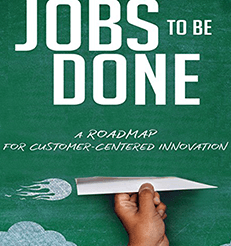Read Jobs To Be Done To Uncover Your Next Innovation » Pixallus

An introduction to the Jobs to be Done process for businesses looking to become more innovative.
Jobs to Be Done
Do you ever get the feeling like there is so much more opportunity for your business, but you just can’t see it?
If so, then you’re going to want to take a close look at my latest read, Jobs to be Done: A Roadmap for Customer-Centered Innovation by Stephen Wunker, Jessica Wattman and David Farber.
What is Jobs to Be Done?
Customers always have the answers to where the next big “thing” will be. And customers are terrible at envisioning the product that solves their problems.
As Steve Jobs had said “Customers don’t know what they want until we show them.”
So how do you figure out what customers want so that you can develop the product they didn’t know they wanted?
There’s a process for that – and it’s called “Jobs to be Done.”
The Jobs to be Done process was pioneered by Harvard Business School Professor Clay Christensen. “Jobs to be Done” is a way to look at the products or services that people buy today from the perspective of what “jobs” they’ve hired these products to do.
The Jobs to be Done Process
Jobs to be Done sounds a lot simpler than it is. While it’s relatively easy to understand the idea that consumers “hire” products or services or features to do a job, it’s a lot more difficult to put this idea to use.
The Jobs to be Done process can help you:
How to Read the Book
The book is broken up into two sections. In section one, they authors explain the Jobs to be Done concept and process.
Section one also introduces readers to the Jobs Atlas which is comprised of three milestones:
Overall, I found this section a bit confusing. Even though the authors provided lots of visual elements, charts and examples, I kept trying to apply the concepts to clients and projects of my own. As I reflect on this, I might have tried to apply the concepts too soon.
It might be a better idea to read through part one and get into part two.
The second section is the implementation section and will show you how to actually use the process to turn customer insights into innovative solutions.
Customer Research is at the Core of Success
At its core, the Jobs to be Done process is all about customer research. And, while you can certainly use traditional market research tools and methods, it’s critical that you focus on looking for the right questions to ask and the right group of customers to ask.
So, if you aren’t clear about who your customers are or haven’t segmented your customers yet, you’ll want to take this opportunity to think that through.
You can start with your existing customers and start understanding what they are buying and see what they can tell you that your products or services are good or bad at. They can also tell you whether your product is being used differently from the problem you thought you were solving.
Here’s a fun “Did you know” from the book.
Did you know that Kleenex tissues weren’t developed for blowing their nose! Nope. They were originally created to help women remove makeup!
Let that sink in.
Kleenex literally doubled their audience when they discovered that both men and women use Kleenex.
About The Authors
The primary expert in Jobs to be Done is Stephen Wunker who has worked side by side with Clay Christensen for years. As a result, he has developed a process for implementing the Jobs to be Done framework in your business. His co-authors Jessica Wattman and David Farber are his colleagues at New Market Advisors, a firm that helps companies implement the Jobs to be Done innovation process.
There is no doubt about the fact that “Jobs to be Done” is a remarkable breakthrough in helping businesses develop innovative products that truly help customers.
This book is and can be extremely helpful in helping you understand what “jobs” your customers are hiring you to do. But, don’t expect to read it through once and have some breakthrough that sends your business rocketing through the roof. Instead, read the book through once. Then go back and work through the process for yourself and your projects.
So, if you’re picking up this book, consider its job to open your mind to new ways of looking at your customers and all the different jobs your product does for them.
Image: amazon.com
